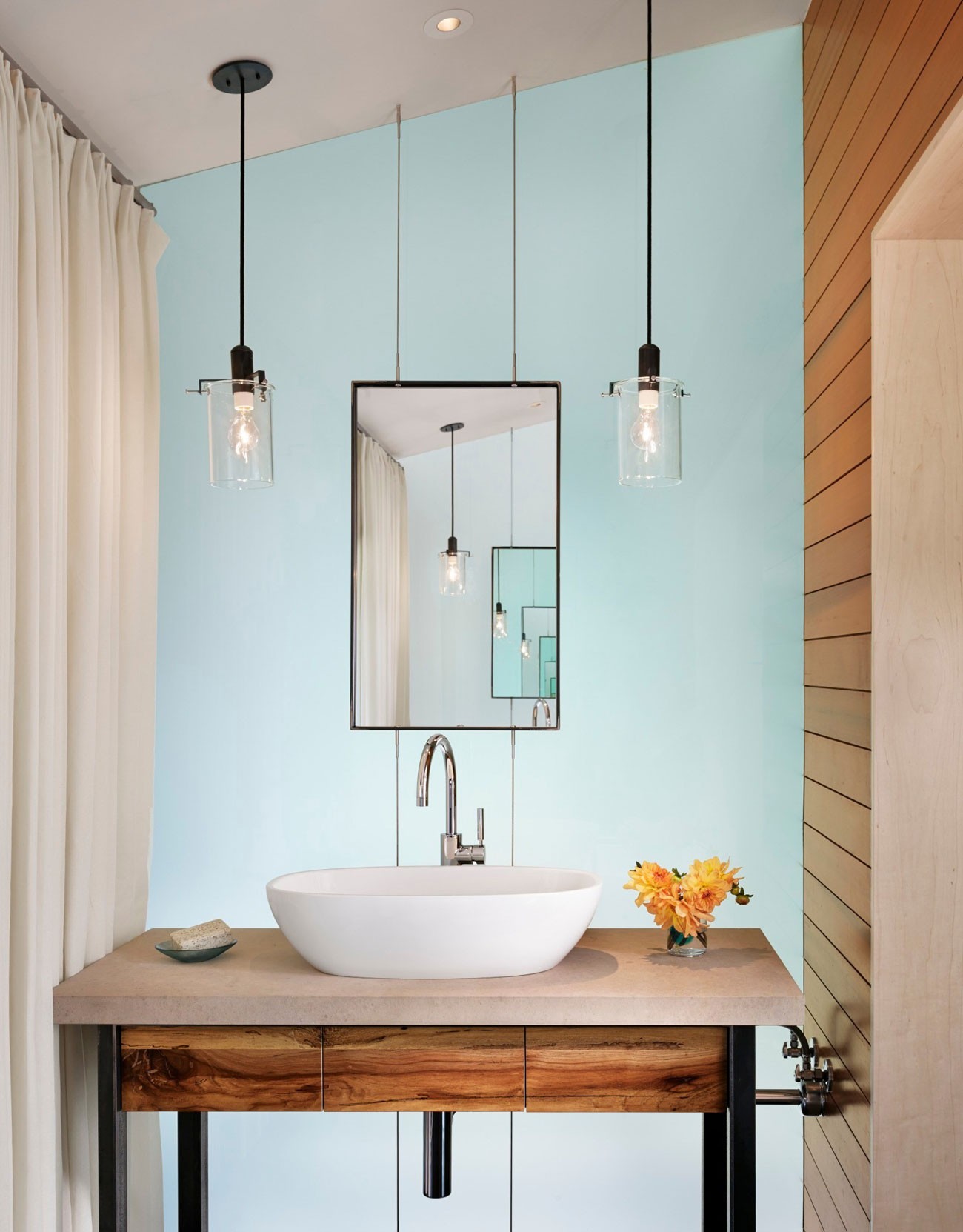Imagine stepping into a bathroom bathed in a warm, inviting glow. This guide illuminates the path to transforming your bathroom into a radiant sanctuary with the strategic use of hanging lights. From the elegant drama of chandeliers to the minimalist chic of cord pendants, we’ll explore the spectrum of styles, placement strategies, and inspiring ideas that will elevate your bathroom from functional to fabulous. Let’s brighten up your bathroom together!
Illuminating Style: Choosing the Right Hanging Light
Hanging lights, also known as pendant lights, play a pivotal role in setting the mood and ensuring adequate illumination for essential bathroom tasks. This section unveils the diverse world of hanging light styles, helping you select the perfect fixture to match your bathroom’s personality.
- Chandeliers: For a touch of grandeur, a chandelier can infuse your bathroom with elegance and drama, particularly in larger spaces.
- Cord Pendants: Embracing simplicity and chic, these lights showcase exposed bulbs and minimalist designs, perfect for modern and industrial aesthetics.
- Downlights: These task-oriented lights shine directly downwards, making them ideal for illuminating vanity areas and ensuring flawless makeup application.
- Encased Pendants: Diffusing light gently, these fixtures create a soft, warm glow, fostering a cozy and inviting atmosphere.
- Globe Pendants: Versatile and timeless, globe pendants seamlessly integrate into various bathroom styles, adding a touch of modern flair.
- Inverted Pendants: Directing light upwards, these fixtures generate an indirect, ambient glow, creating a subtler, more atmospheric lighting scheme.
- Lantern Pendants: Whether rustic or classic, lantern pendants add a touch of charm and character to your bathroom.
- Linear Pendants: Sleek and contemporary, these elongated lights are perfectly suited for illuminating longer vanities or mirrors.
Orchestrating Light: Layering for Depth and Functionality
While hanging lights often take center stage, they can shine even brighter when paired with supporting fixtures. Incorporating bath bars, flush mounts, or wall sconces creates a layered lighting scheme that ensures every corner is well-lit and adds depth to your bathroom’s ambiance.
Perfect Placement: Finding the Ideal Hanging Height
The ideal height for your hanging lights depends on your ceiling height. A general guideline suggests a 12-20 inch gap between the bottom of the light and the countertop for an 8-foot ceiling. For every additional foot of ceiling height, consider adding another 3 inches to the drop. Ultimately, the perfect height is determined by what looks and feels best in your space.
Matching Style and Substance: A Harmonious Bathroom Design
Selecting the right hanging light style is akin to choosing the perfect accessory. It should complement your bathroom’s overall aesthetic, whether modern, farmhouse, traditional, or eclectic.
Practical Considerations: Navigating Bathroom Challenges
Bathrooms present unique challenges due to their humid environment. Consider these essential factors:
- Moisture Resistance: Opt for fixtures rated for damp or wet locations to prevent damage and ensure safety.
- Brightness and Color Temperature: Wattage dictates brightness, while Kelvin (K) measures color temperature. Lower Kelvin values (2700-3000K) emit a warm, yellowish light, while higher values (3500-4100K) create a cooler, bluish light.
- Dimmability: A dimmer switch allows you to adjust brightness and create various moods, from invigorating morning light to relaxing evening ambiance.
Can You Put a Hanging Light in a Bathroom? Absolutely!
Hanging lights can transform a bathroom into a stylish retreat. However, safety is paramount, especially in damp environments. Let’s explore the key considerations for safely and effectively incorporating hanging lights into your bathroom.
IP Ratings: Shielding Against Moisture
Ingress Protection (IP) ratings indicate a fixture’s resistance to moisture and dust. The higher the IP rating, the better the protection. For lights near water sources, like showers or bathtubs, an IP44 rating or higher is generally recommended. For areas further away, an IP20 rating might suffice. Ongoing research continually updates these recommendations, so staying informed is crucial.
Style and Scale: Finding the Perfect Fit
The beauty of hanging lights lies in their diverse range of styles. Sleek pendants lend a modern touch, while ornate chandeliers evoke classic elegance. For lower ceilings, flush-mount or semi-flush fixtures are often more suitable. Consider your bathroom’s existing décor and choose fixtures that enhance its style, whether rustic farmhouse or minimalist chic. Materials also play a key role; consider how different finishes complement your bathroom’s hardware and color scheme.
Installation: Professional Expertise Recommended
Installing hanging lights often involves electrical wiring. While some homeowners may feel comfortable tackling this themselves, it’s generally advisable to consult a qualified electrician, especially in a bathroom setting. Professional installation ensures safety and compliance with electrical codes.
Maintenance: Keeping Your Lights Sparkling
Regular dusting with a slightly damp cloth can prevent grime buildup. Replace bulbs promptly as they burn out to maintain optimal illumination.
What Type of Light Fixture Is Best for a Bathroom? A Layered Approach
Choosing bathroom lighting involves balancing style and functionality. The size of your bathroom, ceiling height, and overall design all influence your fixture choices. Let’s analyze the various options:
Vanity Lights: Task Lighting for Grooming
Vanity lights, positioned flanking or above the mirror, provide essential task lighting for grooming. Aim for a total illumination of around 150 watts.
Pendant Lights: Statement Pieces and Focal Points
Pendant lights add a touch of drama and can serve as focal points. They are particularly well-suited for bathrooms with higher ceilings.
Sconce Lighting: Space-Saving and Focused Illumination
Wall-mounted sconces offer focused light and save valuable counter space. They are ideal for flanking mirrors or highlighting specific features.
LED Strip Lighting: Versatile and Energy-Efficient
LED strips offer incredible versatility and energy efficiency. They can be placed under cabinets, behind mirrors, or within shower niches for a subtle glow.
Choosing Wisely: Factors to Consider
-
Bathroom Size: Smaller bathrooms benefit from space-saving fixtures, while larger bathrooms can accommodate more substantial pieces.
-
Ceiling Height: Low ceilings require flush or semi-flush mounts, while high ceilings allow for pendants or chandeliers.
-
Natural Light: Supplement limited natural light with brighter fixtures. Dimmer switches offer flexibility in adjusting light levels.
-
Safety: Prioritize safety by choosing fixtures with appropriate IP ratings for bathroom use.
Which Light is Good for a Bathroom? A Holistic Approach
Choosing bathroom lighting involves considering several factors to create the ideal atmosphere and functionality. Let’s delve deeper into these considerations.
Size and Scale: Proportionality is Key
The size of your light fixture should be proportionate to your bathroom’s dimensions. A small pendant light might look lost in a large bathroom, while an oversized chandelier can overwhelm a small space.
Style Harmony: Complementing Your Bathroom’s Aesthetic
Your lighting should harmonize with your bathroom’s overall design. A vintage-inspired bathroom might benefit from an ornate chandelier, while a modern bathroom might suit a sleek pendant light.
Strategic Placement: Optimizing Functionality and Ambiance
Placement greatly impacts both functionality and ambiance. Task lighting around the mirror is essential for grooming, while ambient lighting creates overall illumination.
Popular Bathroom Lighting Choices: A Quick Overview
| Light Fixture Type | Description | Best For | Potential Drawbacks |
|---|---|---|---|
| Chandelier | Elegant, often ornate fixture with multiple lights | Large bathrooms with high ceilings | Can be overwhelming in small spaces |
| Pendant | Versatile, single or multi-light fixture hung from the ceiling | Various bathroom styles, adaptable to different sizes | Might not provide sufficient overall light |
| Sconce | Wall-mounted fixture, often in pairs | Smaller bathrooms, task lighting beside mirrors | May cast shadows if not positioned carefully |
| Recessed Lighting | Discreet fixtures installed within the ceiling | Modern bathrooms, overall illumination | Can feel impersonal if used alone |
| Vanity Light Bar | Horizontal fixture mounted above the mirror | Task lighting for grooming | Can be harsh if not paired with other lighting |
Layered Lighting: A Symphony of Illumination
Combining different lighting types – ambient, task, and accent – often provides the best approach for creating a well-lit and inviting bathroom.
Professional Installation: Ensuring Safety and Compliance
Always have electrical work in your bathroom performed by a qualified electrician to ensure safety and adherence to building codes.
Bathroom Zones and IP Ratings: A Safety Essential
Bathroom electrical safety is paramount. Understanding bathroom zones and corresponding IP ratings is crucial:
- Zone 0: Inside the bath or shower – requires at least IP67.
- Zone 1: Above the bath or shower to a height of 2.25m – requires at least IP45.
- Zone 2: 0.6m outside the bath/shower to 2.25m high – requires at least IP44.
- Zone 3: Beyond Zone 2 – less stringent IP rating requirements.
Enhancing Your Space: Green Walls and Beyond
Are you looking for innovative ways to enhance your bathroom’s aesthetic appeal? Consider incorporating greenwalls for a touch of natural beauty and improved air quality.
By carefully considering these factors, you can create a bathroom lighting scheme that is both functional and aesthetically pleasing.
- How to Remove Water Stains from Fabric: A Complete Guide - April 26, 2025
- How to Get Motor Oil Out of Clothes: Proven Methods & Expert Tips - April 26, 2025
- How to Get Deodorant Out of Black Shirts: Easy Stain Removal Guide - April 26, 2025










